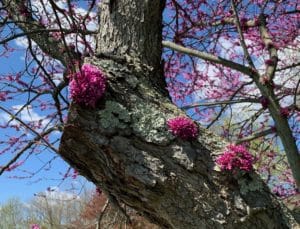Hello Fellow Readers, The spring sure is unfolding at an unusual pace. Many are asking why the leaves on trees look stunted—or reporting perennials that haven’t come back. Give it time. Much has to do with soil temperatures, but Mother Nature has a way of sorting things out.
 During the snow flurries the day before Mother’s Day, I scurried around putting sheets on top of some things and dragged the potted gardens of perennials into the garage. Still, some plants froze their little faces, as my dear Mom would say, like the Palibin lilac causing the top foliage to go limp. Thankfully the blooms appear unaffected. For now, I’ll let it be. Likely the soft leaves will dry out about when the flowers fade, which will be an appropriate time to prune this beauty.
During the snow flurries the day before Mother’s Day, I scurried around putting sheets on top of some things and dragged the potted gardens of perennials into the garage. Still, some plants froze their little faces, as my dear Mom would say, like the Palibin lilac causing the top foliage to go limp. Thankfully the blooms appear unaffected. For now, I’ll let it be. Likely the soft leaves will dry out about when the flowers fade, which will be an appropriate time to prune this beauty.
Syringa meyeri’ Palibin’ only grows about four to five-foot-high, so pruning is not necessary. But if you desire to manage size, the rule of thumb for pruning flowering shrubs is right after they bloom. That way, they’ll flower the following year.
Cut back damaged foliage on the butterfly bush (Buddleia davidii) and other perennials impacted by the freeze to prevent disease and encourage new sprouts.
Why some plants are late to emerge
Earlier in the spring, Ed of Basking Ridge reported that his newly planted Redbud (Cercis Canadensis) and Glossy abelia (A. x grandiflora) did not make it, both planted in the fall. Fast forward to a week ago; Ed said they are very much alive. Experts say that because the winter was so mild and the spring so chilly, some plants are slow to emerge. Once we have a continuous warm spell, they’ll catch up— which recalls the topic of soil temperature.
Soil temperature indicates the time to plant
While shopping for plants just after Mother’s Day a handful of years ago, I met Phil from Morristown NJ, who advised that it is too soon to plant tomatoes as our nights need to be above 40 degrees. No doubt, planting at the right time is as essential as water and nutrients. And, following the calendar isn’t always accurate because temperatures vary as we experienced this year. The more precise determination of when to plant is soil temperature.
There are soil temperature maps available online, but taking your soil’s temperature is the most accurate way. There are high-tech thermometers with digital readings that beep when ready, but an analog soil thermometer for less than fifteen bucks is just as useful. They work much like the human ones, which would be the in-the-bottom variety that Mom always touted as most accurate. Simply stick the soil thermometer probe into the soil about six inches for about a minute or until Mr. High-tech beeps. You can even use an instant-read thermometer made for cooking.
Ideal soil temps for seed germination
Seed germination temps range from 40 degrees or warmer for lettuce, kale, peas, and spinach, 50 for onions, turnips, Swiss chard, 60 for broccoli, cabbage, cauliflower, carrots, beans, and beets and 70 for tomatoes, squash, corn, cucumbers, melons, and peppers. Once established, many veggies can handle cooler air temperatures as long as the soil is warm enough, which is why starter plants can give some plants a jump start.
Check the temperatures where you intend to plant each crop. Be sure to test midday for at least three days. Average the readings by dividing the total by the number of days taken. And no faking a fever to avoid doing your schoolwork.
Garden Dilemmas? AskMaryStone@gmail.com (and now on your favorite Podcast App.)
Speaking of Redbuds- I posted this picture of an old tree with a large cut branch, likely because a branch broke during an ice storm. There were bright pink clusters of blooms along the remaining limb. I wrote: I can’t help but admire the pom-poms on this old Eastern Redbud. Talk about resilience!
A gardener friend wrote, Wow, Beautiful! Latent buds? Indeed, they are Ruth; with any luck, those little pom-poms will turn into new shoots.
To learn more about Redbuds check out a previous column titled Urban Gardens




